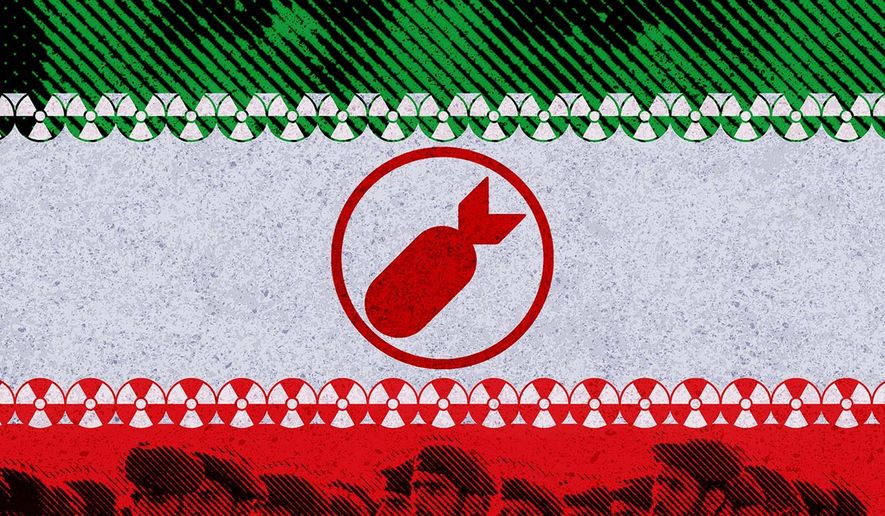OPINION:
Iranian security forces in recent days have been arresting civilians chanting “Death to the dictator” as nationwide protests grip the country after 22-year-old Mahsa Amini died last month in the custody of Iran’s “morality police” for the crime of wearing her mandatory headscarf too loosely. Each time ordinary Iranians have bravely taken to the streets since the 1979 revolution, most famously during 2009’s Green Movement, the shock troops of Iran’s Revolutionary Guard Corps (IRGC) have brutally suppressed their popular dissent.
The IRGC is an elite branch of Iran’s armed forces known as the “Army of Guardians of the Islamic Revolution,” which the late Ayatollah Khomeini created in 1979 to protect the extremist regime from its domestic and foreign enemies.
A security, intelligence, economic and paramilitary superstructure, the IRGC serves as the Iranian regime’s intimidating roughneck at home and its tool for the belligerent projection of power abroad. Branches of the IRGC control the country’s key industries including oil, construction, manufacturing and electronics.
The State Department designated Iran as an official “state sponsor of terrorism” in 1984. But it was only in 2019 that the Trump administration designated the IRGC itself as a foreign terrorist organization, one that “actively participates in, finances and promotes terrorism as a tool of statecraft.”
Every week, Iran’s clerical leadership leads “Death to America” chants in their Friday prayer sermons. And the IRGC puts those threats into action by training, delivering weapons, and financing terrorist groups such as Lebanon’s Hezbollah, Hamas and Palestinian Islamic Jihad.
The IRGC, especially under the ruthless leadership of Gen. Qassem Soleimani, whom the Trump administration killed with a drone strike in 2020, has a long history of nefarious doings: providing material support to Iran’s proxy Shiite militants in Iraq, responsible for lethal attacks on U.S. military and installations in country; propping up Syrian dictator Bashar Assad; providing weapons and training to terrorists in Bahrain; and delivering advanced weapons, including drones, to Houthi militants in Yemen.
Iran also has a long history of offering al-Qaida’s leadership and key facilitators sanctuary on its territory. In August 2020, Israel reportedly launched a lethal strike in Tehran on al-Qaida’s then second-in-command, Abu Muhammad al-Masri, who helped plan the 1998 bombings of U.S. embassies in Kenya and Tanzania. In 2011, a U.S. federal judge ruled that Iran was liable for the bombings, concluding that “prior to [the plotters’] meetings with Iranian officials and agents, [Osama] bin Laden and al Qaeda did not possess the technical expertise required to carry out the embassy bombings in Nairobi and Dar es Salaam.”
In 2015, federal Judge Rudolph Contreras ruled that “Iran was directly involved in establishing al Qaeda’s Yemen network and supported training and logistics for al Qaeda in the Gulf region” through Hezbollah, and therefore shared responsibility for the deadly attack on the USS Cole, a Navy ship, in October 2000 in the Yemeni port of Aden.
The 9/11 Commission reported that eight of the 10 9/11 hijackers received assistance from Iranian border guards during their travel through Iran. And the most likely successor to Ayman al Zawahiri, bin Laden’s successor as head of al-Qaida recently killed by a U.S. strike in Kabul, Afghanistan, is one Saif al Adel, who is reportedly enjoying safe haven in Iran.
Just this August, the Department of Justice charged IRGC operative Shahram Poursafi with plotting to assassinate former Trump White House national security advisor John Bolton. Former Secretary of State Mike Pompeo was also reportedly a target.
The IRGC is also intertwined with Iran’s nuclear program. In 2020, Israel conducted a lethal strike on Iran’s nuclear weapons mastermind Mohsen Fakhizadeh, who also happened to be an IRGC brigadier general.
Reviving the deeply flawed 2015 Iran nuclear deal — which limited Iran’s nuclear program for only a set period of years and addressed neither Iran’s ballistic missile program nor record of supporting terror groups — would be a horrific national security policy blunder, especially if the Biden administration accedes to Tehran’s demand that the International Atomic Energy Agency close its investigations into Iran’s past undeclared nuclear activity.
Sanctions relief, oil exports, and increased international investment in Iran would only fill the IRGC’s coffers and by extension its capacity to inflict harm on the U.S. and our allies.
With the exception of the notable strike on Soleimani, the U.S. has failed to hold Iran accountable for its terrorist attacks and attempted assassinations. Deterring Iran would become even more challenging if the mullahs in Tehran acquired a nuclear weapon.
Iran’s blatant military provocations and relentless demands for concessions likely reflect its assessment that President Biden is desperate to avoid having to resort to a “Plan B” military strike if the nuclear talks collapse. Preventing Iran, the most prolific and dangerous state sponsor of terrorism, from acquiring a nuclear weapon is a wickedly complex challenge. But the Biden administration had better have an alternative strategy at the ready or be prepared to face the consequences of a nuclear-armed terrorist state.
• Daniel N. Hoffman is a retired clandestine services officer and former chief of station with the Central Intelligence Agency. His combined 30 years of government service included high-level overseas and domestic positions at the CIA. He has been a Fox News contributor since May 2018. Follow him on Twitter @DanielHoffmanDC.




Please read our comment policy before commenting.